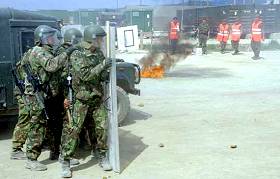





The KFOR is prepared for a hot summer
June 23, 2001

he British acting Police Forces slowly advance straight towards the thunderstorm of incoming, low flying potatoes. The crowd is as violent as could possibly be, according to the orders given by the exercise co-ordinator. Suddenly, a petrol bomb is thrown at the good guys followed by the umpteenth charge of the mob shouting: "KFOR HOME!"
No doubt, KFOR is prepared for a hot summer. "British forces normally undergo this kind of riot control exercise," says Major Terry Ness, 2nd in Command of the 2nd Royal Tank Regiment in Batlava.
In prevision of a possible employment of the Battle Groups in a situation of clashes in a city, the Multi National Brigade Center HQ decided to start a series of specific training exercises. For instance, riot control. "We thought that the most experienced in this field were the Carabinieris, and after being invited, the MSU immediately accepted," says Maj. Jonas Ericsson, Training Officer of the MNB (C).
Under a relentless sun, and on an Army standard dusty training area, both the British and the MSU showed their techniques to control riots in an urban area. The first big difference noticed was the equipment. The British have got a long modular individual shield, of about two meters in height, which can be fitted together to another shield to make a protective wall.
On the contrary, the MSU Carabinieri have a smaller type of shield, which can cover a man only if he kneels down. To protect a full line of soldiers, the Carabinieris have to assume a two line formation; the first line kneeling behind their shield, and the second standing right behind the first line, holding their shields in front so the two shields make a full man coverage.

Also, the techniques of movement and deployment were quite different even if aimed to achieve the same result. "I think that the difference is also connected to the level of training and practical activity that the soldiers are used to," says 1st LT Stefano Saccocci, the MSU Platoon Leader, to the Chronicle.
All the Carabinieris under his command belong to a Mobile Battalion that is normally employed in these kind of activities, at football matches or political rallies. "The problem with these kind of riots, is that the crowd can disperse from one point to reappear the minute after somewhere else," says Major Paolo Zanaroli.
For this reason the Carabinieri techniques are more "fluid" to follow the events with the same rapidity, but at the same time, very drastic. "Our necessity is to disperse the crowd and to force it to stop," he adds. The higher average age of the Carabinieris and their experience from being engaged in city clashes, made them really a tough opponent for the young British soldiers playing the role of the crowd.
"It is really good fun anyhow," says Cpl. Simon Hands, after the first fierce close encounter with the blue MSU soldiers. Both the crowd and the Riot Control Units were composed of soldiers from the 2nd RTR BG and the 1st Battalion, The Duke of Wellington's Regiment (West Riding). The units played also combined with an MSU platoon to perform a relief-in-place exercise together with the DWR soldiers. Very active on the "bad guys" side, Major Gary Brown found the exercise very good and informative for the soldiers.
The last exercise and the Carabinieris played the crowd. The experience gained on the field was again, in favor of the MSU who discovered the weakness of the long British shield exactly in the height. Urged by the public, the MSU crowd jumped in front of the soldiers and grabbed the shields from the top. In this way, the Carabinieris were able to discard the "Base line" formation, taking with them several shields.
But that's what exercise and training is for, and both the tanker and the riflemen of the two British units will certainly keep all they experienced in mind for the future. After that, the sound of a horn declared the end of the exercise, all the participants, public, soldiers and crowd, burst into a long lasting applause.
A final event by a "Challenger" MBT showed the impressive power and quickness of over seventy steel tons of heavy vehicle moving over a barricade, letting out smoke and withdrawing after a short time of engagement. The one-day training was very much appreciated by the 2nd RTR Commander, Lt. Col. Allison who followed every step of the exercise.
Text source: Capt Cristiano Dechigi, KFOR Online, May 16, 2001
© 2001 CheckPoint |














